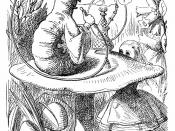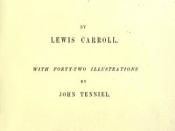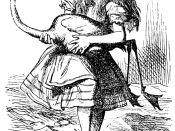Alice gradually explores Carroll's Wonderland in Alice's Adventures in Wonderland, serving as a guide for the reader through this world. Carroll's world of nonsense reflects a different type of speech where statements of characters are taken literally. This method of storytelling stands as a foundation in Carroll's world. He accentuates his mastery of the subtleties of semantics, which appears to be an underlying principle of nonsense in the book. Nonsense is the essence of metalanguage in Wonderland in which speech semantics dominate.
Marret expresses clearly that in Alice's Adventures in Wonderland and Through the Looking-Glass, Carroll's intuitions of emptiness and nonsense are the foundations of this subject and language (217). Nonsense serves as a way of structuring Carroll's world, and the chaotic use of figurative language comprises it. In this book, Carroll builds the text on associative conformity and polysemies. Many retorts are constructed on a word game. In Carroll's book, practically each word has a sense of duality.
His understanding of metalanguage aims to disclose the structures generating sense.
In the article, Sophie Marret implies that the difference between language and metalanguage appears to be purely semantic (220). Carroll must be aware of this difference, as he illustrates it through the conversation between Alice and the White Knight about the "name of the song" and the "name of the name of the song". By emphasizing the difference between the name and thing, he makes the distinction between the levels of metalanguage in relation to meaning in language and logic.
A word in itself serves as a game of nonsense in Carroll's Wonderland. The numerous puns on words built into both Carroll's stories function as a game of sound and meaning. For example, in "The long story" by the Mouse (Lewis Carroll, pg. 28), a semantic nonconformity of words...


